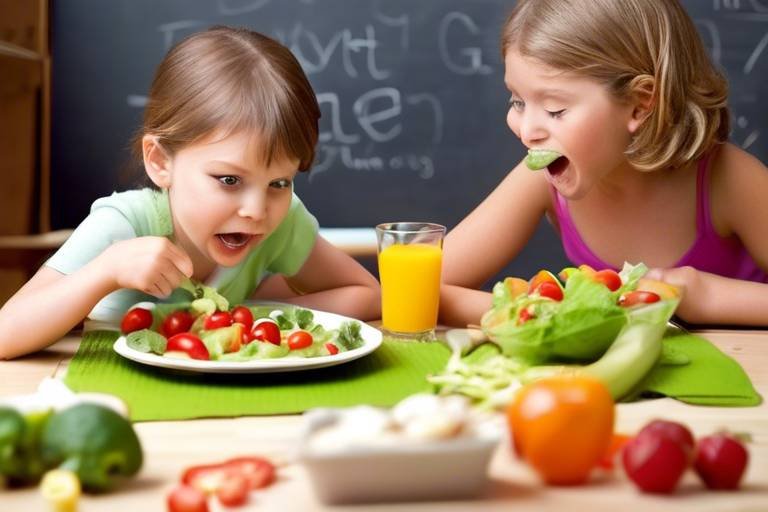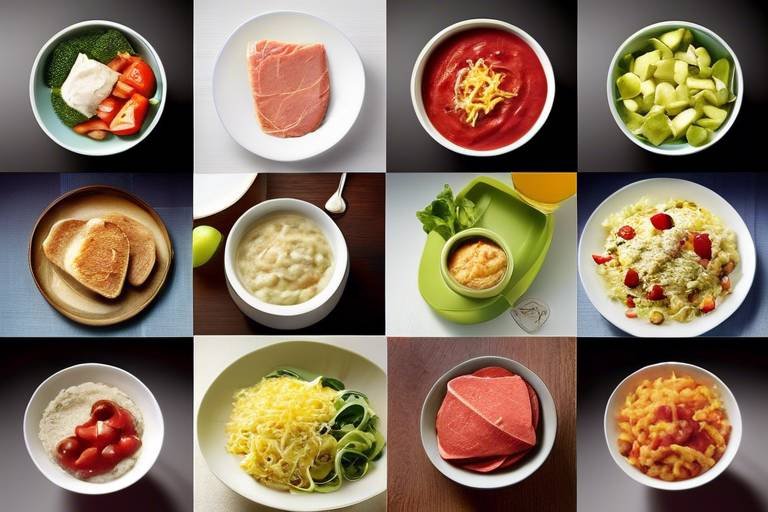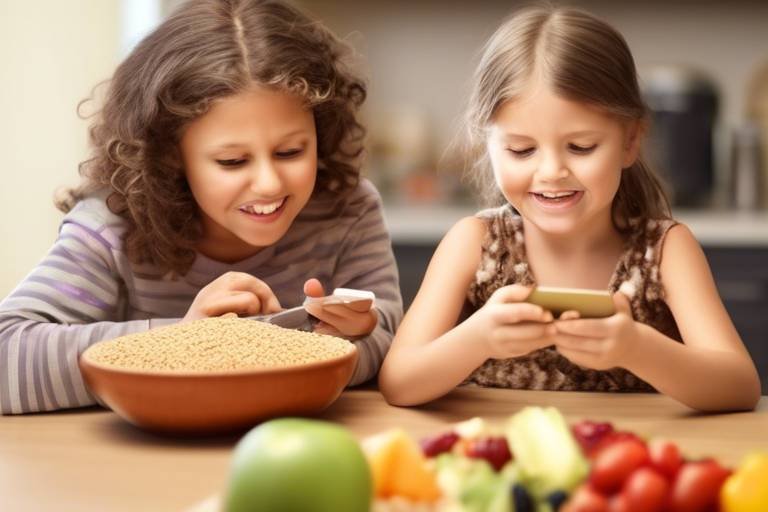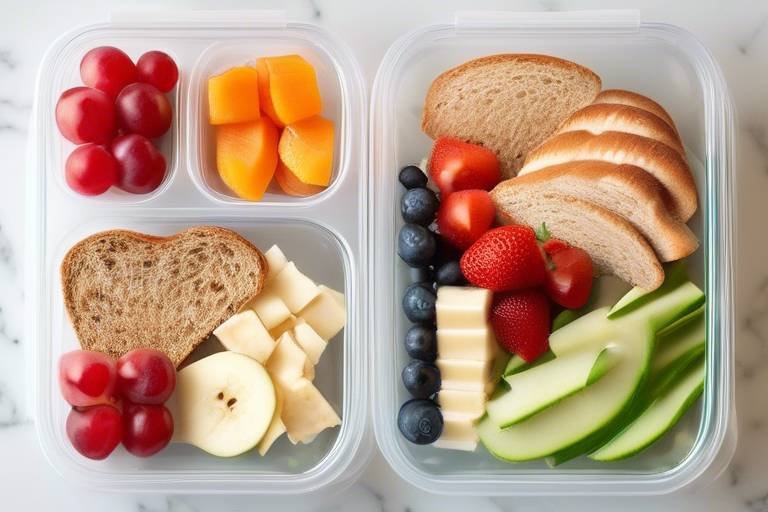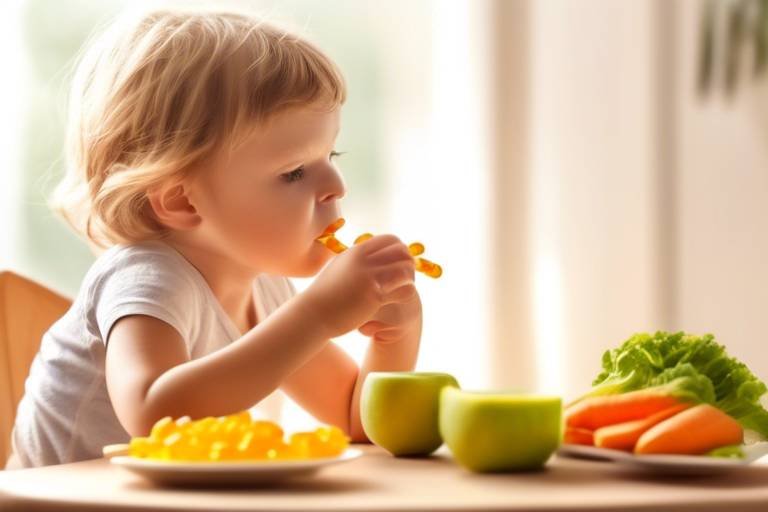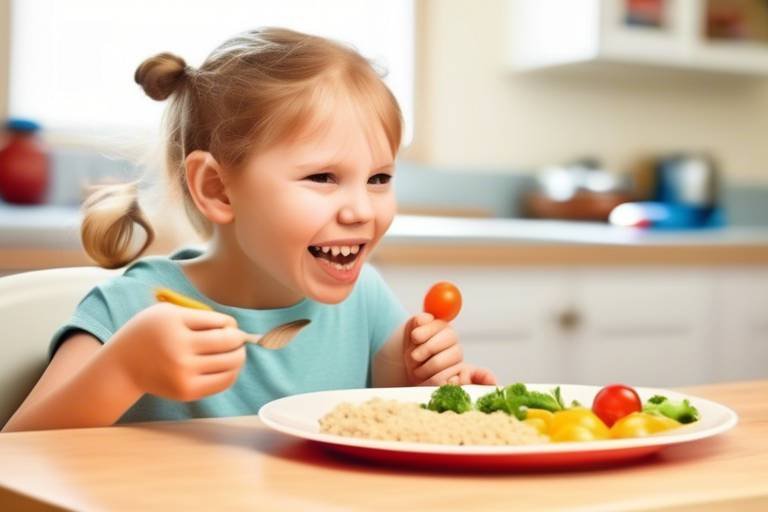Teaching Your Kids About Healthy Eating
In today's fast-paced world, teaching your kids about healthy eating is more crucial than ever. With the rise of fast food and sugary snacks, it's easy for children to develop poor eating habits that can last a lifetime. But what if you could turn this challenge into a fun and engaging experience? By introducing your children to the joys of healthy eating early on, you can help them develop a positive relationship with food that will serve them well throughout their lives. Imagine your child excitedly choosing a colorful salad over a greasy burger, or eagerly participating in meal preparation. Sounds like a dream, right? Well, it can be a reality!
Understanding the importance of nutrition is the first step. Healthy eating isn't just about avoiding junk food; it's about fueling their growing bodies with the right nutrients. Kids need a variety of vitamins and minerals to support their rapid growth and development. Think of their bodies as cars; without the right fuel, they won't run efficiently. By teaching them about the benefits of healthy foods, you can motivate them to make better choices. For instance, did you know that fruits and vegetables are packed with antioxidants that help boost their immune system? Or that whole grains provide the energy they need to stay active and focused at school? When kids understand how food impacts their bodies, they are more likely to make healthier choices.
But how do you make learning about healthy eating fun? This is where engaging activities come into play! Incorporating hands-on experiences, such as cooking together or gardening, can turn the learning process into an adventure. Imagine planting a seed, watching it grow, and then harvesting the fruits of your labor. It’s not just educational; it’s magical! Kids love to see the connection between what they grow and what they eat. Plus, cooking together can be a wonderful bonding experience. It’s an opportunity for laughter, creativity, and yes, even a little mess! And who knows? You might just discover a budding chef in your kitchen.
Involving kids in meal planning is another effective strategy. When children help choose what’s for dinner, they feel a sense of ownership over their food choices. You can guide them to understand balanced nutrition by discussing the various food groups and what makes a meal nutritious. For example, you could create a simple chart together that outlines the different food groups and examples of healthy options. This not only empowers them but also makes them more likely to try new foods. Remember, the goal is to create a positive atmosphere around food, where trying new things is celebrated rather than feared.
As parents, you play a vital role in shaping your children's eating habits. If they see you enjoying a variety of healthy foods, they are more likely to follow suit. Modeling healthy eating behaviors is one of the most powerful tools you have. Make family meals a priority, and use this time to discuss the day while enjoying nutritious food together. This way, you’re not just feeding their bodies; you’re also feeding their minds and hearts.
In conclusion, teaching your kids about healthy eating doesn't have to be a daunting task. By making it fun, engaging, and informative, you can instill lifelong habits that promote wellness. With a little creativity and a lot of love, you can help your children develop a positive relationship with food that will benefit them for years to come. So, are you ready to embark on this delicious journey together?
- What are some healthy snacks for kids? Fruits, vegetables with hummus, yogurt, and whole-grain crackers are great options.
- How can I get my picky eater to try new foods? Encourage them to taste new foods by making it a fun game or involving them in cooking.
- Is it okay to let kids have sweets? Moderation is key! It's important to balance treats with healthy foods.
- How can I involve my kids in meal planning? Sit down together and look through cookbooks or websites to choose meals they’d like to try.

The Importance of Healthy Eating
Understanding why healthy eating is essential for children can be a game-changer when it comes to motivating them to make better food choices. Think of nutrition as the foundation of a house; without a solid base, everything else can crumble. Nutrition plays a pivotal role in a child's growth, development, and overall health. When children consume a balanced diet rich in fruits, vegetables, whole grains, and lean proteins, they fuel their bodies with the nutrients necessary for optimal performance both physically and mentally.
One of the most significant benefits of healthy eating is its impact on growth and development. Children need a variety of nutrients to support their rapidly growing bodies. For instance, calcium and vitamin D are crucial for building strong bones, while iron is essential for developing healthy blood cells. A well-rounded diet helps children reach their full potential in terms of height, weight, and general health. Furthermore, a nutritious diet can enhance cognitive functions, enabling kids to focus better in school and perform well academically.
Moreover, instilling healthy eating habits early on can lead to lifelong benefits. When children learn to appreciate nutritious foods, they are more likely to carry these habits into adulthood. They become more aware of their food choices and the consequences that come with them. For example, understanding that sugary snacks can lead to energy crashes or weight gain helps them make informed decisions. Additionally, a diet rich in fruits and vegetables can reduce the risk of chronic diseases later in life, such as obesity, diabetes, and heart disease.
Healthy eating is not just about what kids eat; it’s also about how they feel. A balanced diet can improve mood and energy levels, making children feel more vibrant and ready to take on the day. When kids eat well, they are less likely to experience mood swings or fatigue, which can affect their social interactions and academic performance. This emotional aspect of nutrition is often overlooked but is equally important in fostering a positive relationship with food.
In conclusion, the importance of healthy eating cannot be overstated. It is the cornerstone of a child’s physical, mental, and emotional well-being. By understanding the benefits of nutrition, children can be motivated to make better food choices that will serve them well throughout their lives. Remember, it's not just about eating; it's about creating a lifestyle that promotes health, happiness, and longevity.
- Why is healthy eating important for children? Healthy eating supports growth, development, and overall well-being, helping children thrive both physically and mentally.
- What are some key nutrients children need? Children need calcium, iron, vitamins, and minerals to support their growth and cognitive functions.
- How can I encourage my child to eat healthier? Involve them in meal planning, cooking, and shopping, and model healthy eating behaviors yourself.

Engaging Activities for Kids
When it comes to teaching kids about healthy eating, the key is to make it fun and engaging. Children are naturally curious and love to explore, so why not channel that energy into learning about nutrition? By incorporating interactive activities into their daily routines, you can create lasting memories while instilling healthy habits. Imagine transforming the kitchen into a vibrant classroom where every meal becomes an opportunity for discovery! Here are some creative ideas to get started.
One of the most effective ways to engage kids is through cooking together. This not only helps them learn about healthy ingredients but also allows for quality bonding time. Think of it as a culinary adventure where they can experiment with different flavors and textures. Simple recipes, like making fruit smoothies or veggie pizzas, can be both enjoyable and educational. Kids can take turns adding ingredients, measuring, and mixing, which boosts their confidence and culinary skills.
Cooking with your kids is like embarking on a treasure hunt in the kitchen. You can introduce them to a variety of healthy foods while teaching them essential cooking techniques. For instance, let them help with washing vegetables, stirring sauces, or even setting the table. These small tasks can make them feel like they are contributing to the family meal, and they are more likely to try what they've helped prepare. Plus, it’s a fantastic way to sneak in lessons about nutrition and the benefits of each ingredient.
Here are a couple of easy, nutritious recipes that children can help prepare:
| Recipe | Ingredients | Steps |
|---|---|---|
| Fruit Smoothie | Banana, yogurt, berries, honey | Blend all ingredients until smooth. Serve chilled. |
| Veggie Pizza | Pita bread, tomato sauce, cheese, assorted veggies | Spread sauce on pita, top with cheese and veggies. Bake until cheese melts. |
These recipes are not just about cooking; they’re about exploring flavors and discovering new foods. Encourage your children to pick a new fruit or vegetable each week to try, turning mealtime into an exciting adventure.
Of course, while cooking can be a blast, it's vital to prioritize kitchen safety. Here are some essential tips to keep in mind:
- Always supervise young children when using sharp utensils.
- Teach them the importance of washing hands before cooking.
- Show them how to handle hot items safely.
By instilling these safety practices, you not only ensure a safe cooking environment but also foster a sense of responsibility in your children.
Another engaging activity is gardening. There’s something magical about watching seeds transform into fruits and vegetables. By involving your kids in gardening, you help them understand where their food comes from and the effort it takes to grow it. Whether you have a backyard or just a few pots on a balcony, you can start a small garden. Kids can help with planting seeds, watering, and even harvesting. This hands-on experience fosters a deeper connection to nature and an appreciation for healthy foods.
In conclusion, making healthy eating fun for kids is all about engagement and creativity. Whether it’s through cooking together or gardening, the goal is to create positive associations with nutritious foods. Remember, the more involved they are in the process, the more likely they are to embrace healthy eating habits for a lifetime!
Q: How can I get my kids interested in cooking?
A: Start with simple, fun recipes that allow them to participate. Make it a game or an adventure to keep their interest alive!
Q: What if my child refuses to try new foods?
A: Encourage them to taste new foods without pressure. Sometimes, it takes several exposures to a food before a child is willing to try it.
Q: How can I make healthy eating a family affair?
A: Involve everyone in meal planning, cooking, and even grocery shopping. Making it a family activity can help everyone feel included and excited about healthy choices.

Cooking Together
Cooking together with your kids is not just about preparing meals; it’s a wonderful opportunity to bond and create lasting memories. Imagine the laughter and chatter filling your kitchen as you chop, stir, and bake side by side. Not only does this activity encourage children to develop essential culinary skills, but it also instills a sense of pride in what they create. When kids are involved in the kitchen, they are more likely to appreciate the food they eat and understand the importance of healthy ingredients.
One of the best parts of cooking together is the chance to introduce children to new flavors and foods. You can turn meal preparation into a fun adventure by exploring different cuisines from around the world. For instance, why not have a taco night where everyone gets to assemble their own tacos? You can lay out a variety of healthy toppings like fresh veggies, lean proteins, and flavorful sauces. This not only makes the meal interactive but also encourages kids to try new ingredients without feeling pressured.
To make cooking even more engaging, consider involving your children in the selection of recipes. Let them browse through cookbooks or websites to choose dishes they find appealing. This empowers them and gives them a sense of ownership over their meals. You can also teach them about the nutritional value of the ingredients they pick, making the experience both educational and enjoyable.
Here are a few simple recipes that are perfect for cooking together:
- Fruit Kabobs: Kids can help wash, peel, and skewer their favorite fruits. This colorful dish is not only fun to make but also a healthy snack.
- Veggie Pizza: Let your kids spread sauce on whole wheat pita bread and top it with a variety of vegetables and cheese. This encourages creativity and healthy eating.
- Homemade Smoothies: Kids can choose their favorite fruits and help blend them with yogurt or milk. It’s a delicious way to incorporate fruits into their diet.
As you cook, don’t forget to emphasize kitchen safety. Teaching your children about safe knife handling, proper food storage, and hygiene practices will not only keep them safe but also make them feel responsible and grown-up. You can create a fun kitchen safety checklist together, ensuring they understand the importance of each rule. As they gain confidence, they’ll be excited to take on more complex tasks, which can lead to a greater interest in healthy cooking.
Cooking together is more than just a task; it’s an experience filled with learning, laughter, and love. So, roll up your sleeves, put on those aprons, and get ready to whip up some delicious meals while creating cherished family memories!
Q: How can I get my child interested in cooking?
A: Start by involving them in the process. Let them choose recipes, help with shopping, and participate in meal preparation. Make it fun and interactive!
Q: What are some healthy snacks we can make together?
A: Try making fruit kabobs, yogurt parfaits with granola, or veggie sticks with hummus. These are easy and fun to prepare!
Q: How can I ensure my child stays safe in the kitchen?
A: Teach them about kitchen safety rules, supervise them closely, and start with age-appropriate tasks. Gradually introduce more complex skills as they become more confident.

Simple Recipes for Kids
Cooking with kids is not just about preparing meals; it's a wonderful opportunity to bond, have fun, and teach them valuable life skills. When it comes to simple recipes that kids can help with, the key is to keep things easy, engaging, and, most importantly, delicious! Here are a few ideas that will not only tickle their taste buds but also instill healthy eating habits.
One of the easiest recipes to start with is Fruit and Yogurt Parfaits. All you need are some fresh fruits like strawberries, bananas, and blueberries, along with yogurt and granola. Kids can layer the yogurt and fruits in a cup, creating their own colorful parfaits. This activity encourages them to explore different textures and flavors, and they’ll love seeing their creation come to life!
Another fun recipe is the Veggie Pizza. Using whole wheat pita bread as the base, let your children spread tomato sauce and sprinkle cheese on top. Then, it’s time for the fun part—choosing their favorite vegetables! From bell peppers to spinach, kids can pick and place the toppings however they like. Not only does this recipe promote creativity, but it also gets them excited about eating their veggies!
Don’t forget about the classic Banana Pancakes. With just a few ingredients—mashed bananas, eggs, and a pinch of baking powder—kids can mix everything in a bowl and watch the magic happen on the skillet. This recipe is simple and can be customized with add-ins like chocolate chips or nuts. Plus, they’ll feel accomplished flipping their own pancakes!
To make these cooking sessions even more educational, you can introduce a nutritional twist by discussing the health benefits of the ingredients they are using. For example, you might explain how bananas provide energy or how whole grains are important for their growth. This way, cooking becomes a fun learning experience!
Here’s a quick reference table for the recipes mentioned:
| Recipe | Main Ingredients | Fun Factor |
|---|---|---|
| Fruit and Yogurt Parfaits | Fruits, Yogurt, Granola | Layering and Colorful Creation |
| Veggie Pizza | Pita Bread, Tomato Sauce, Cheese, Veggies | Choosing and Arranging Toppings |
| Banana Pancakes | Bananas, Eggs, Baking Powder | Mixing and Flipping |
Remember, the goal is to make cooking a fun and enjoyable experience. Celebrate their successes, no matter how small, and encourage them to experiment with different ingredients. Soon enough, they’ll not only be excited about cooking but also about eating healthy!
Q: What age can my child start cooking with me?
A: Kids can start helping in the kitchen as early as 2-3 years old with simple tasks like washing vegetables or stirring. As they grow, you can introduce more complex tasks.
Q: How can I make cooking more fun for my child?
A: Incorporate games, let them choose recipes, and create a fun cooking playlist. Making it a family event can also enhance the experience!
Q: What if my child is picky about food?
A: Encourage them to try new foods by involving them in the cooking process. Sometimes, helping prepare a dish makes them more willing to taste it!

Kitchen Safety Tips
When it comes to cooking with kids, ensuring their safety in the kitchen is paramount. After all, you want the experience to be fun and educational, not stressful or dangerous. Start by establishing some basic rules that everyone understands. For instance, remind your little chefs that the kitchen is not a playground; it's a workspace where focus and care are essential. You can create a simple list of kitchen safety rules that everyone can refer to, such as:
- Always wash your hands before handling food.
- Use oven mitts when handling hot pots and pans.
- Be careful with sharp knives and other utensils.
- Never leave cooking food unattended.
- Keep the kitchen floor clean to avoid slips and falls.
Another effective way to ensure safety is to designate specific roles for each child based on their age and skill level. Younger kids can handle washing vegetables or stirring ingredients, while older kids can graduate to using a peeler or even a knife under supervision. This not only keeps them safe but also helps them feel accomplished and responsible.
It’s also vital to discuss the importance of using equipment properly. For instance, teach them how to use a knife correctly—using a cutting board, keeping fingers tucked in, and cutting away from their bodies. You might even consider investing in kid-friendly kitchen tools, which are designed to be safer for little hands. As your child becomes more comfortable in the kitchen, you can gradually introduce them to more complex tasks.
Additionally, make sure to talk about fire safety. Explain the dangers of the stove and oven, and ensure they know what to do in case of a fire, such as using a fire extinguisher or calling for help. Having a fire extinguisher within reach and teaching them how to use it can empower them to act responsibly in emergencies.
Lastly, remember to keep the kitchen organized. A clutter-free workspace can significantly reduce the risk of accidents. Teach your children to put away items after they use them and to clean up any spills immediately. This not only promotes safety but also instills good habits that will serve them well throughout their lives.
By focusing on these kitchen safety tips, you can create an environment where your kids feel secure and excited to learn about cooking. The kitchen can become a place of creativity and fun, where children develop a lifelong appreciation for healthy eating and cooking skills while staying safe.
Q1: What age is appropriate for kids to start cooking?
A1: Children can start helping in the kitchen as early as 2 or 3 years old with simple tasks like washing vegetables. As they grow older and gain more skills, they can take on more complex tasks.
Q2: How can I encourage my picky eater to try new foods?
A2: Involve them in the cooking process! Let them help prepare meals and choose ingredients. Making food together can spark their interest in trying new flavors.
Q3: What are some kid-friendly kitchen tools?
A3: Look for tools designed for children, such as plastic knives, measuring cups with easy-to-read markings, and child-sized utensils. These tools are safer and easier for kids to handle.
Q4: How can I make meal prep fun for my kids?
A4: Turn it into a game! You can have themed cooking nights, create a cooking challenge, or even have them help plan the week's meals. The more engaged they are, the more they'll enjoy it.

Gardening and Growing Food
Gardening is not just a hobby; it's a fantastic way to connect your kids with the food they eat. Imagine the joy on their faces as they watch tiny seeds transform into vibrant vegetables and luscious fruits. This hands-on experience teaches children about nature, patience, and the importance of healthy eating. When kids are involved in growing their own food, they develop a sense of ownership and pride that can significantly influence their dietary choices.
One of the most exciting aspects of gardening is the opportunity for children to learn about where their food comes from. It demystifies the process of food production, moving them away from the notion that food simply appears on supermarket shelves. By nurturing plants from seeds to harvest, children gain a deeper understanding of nutrition and the effort that goes into producing healthy food. It’s like watching a magic show, but instead of tricks, they see real-life transformations!
Moreover, gardening can be a great way to introduce a variety of fruits and vegetables to your kids. When they grow their own produce, they are often more willing to try new flavors and textures. For instance, if they’ve cultivated a patch of cherry tomatoes, they’re likely to pop a few into their mouths right off the vine, enjoying the sweet taste of success. This encourages adventurous eating, turning the act of trying new foods into an exciting adventure rather than a chore.
To get started, consider creating a small garden space in your backyard or even using pots on a balcony. Here are some tips to make gardening fun and educational:
- Choose Easy-to-Grow Plants: Start with vegetables like radishes, lettuce, or herbs like basil and mint. These grow quickly and can be harvested in a short time, keeping kids engaged.
- Incorporate Learning: Discuss the different parts of plants, how they grow, and the nutrients they provide. This can turn gardening into a science lesson!
- Make It a Family Activity: Schedule regular gardening days where everyone can participate. This not only builds teamwork but also strengthens family bonds.
Gardening also has therapeutic benefits. It allows children to spend time outdoors, breathe fresh air, and engage in physical activity. In a world where screens often dominate, tending to a garden can be a refreshing break that promotes mental well-being. Plus, it’s a great way to teach responsibility. Caring for plants requires regular watering, weeding, and monitoring growth, instilling a sense of duty and commitment in children.
As the garden flourishes, so will your child's understanding of healthy eating. They will learn to appreciate the effort that goes into growing food and the value of consuming fresh, organic produce. This connection can lead to lifelong healthy eating habits, ensuring that they not only enjoy the fruits of their labor but also make wiser food choices in the future.
In summary, gardening is a powerful tool in teaching kids about healthy eating. It’s a blend of education, fun, and responsibility that can leave a lasting impact on their dietary preferences. So, grab some seeds, get your hands dirty, and watch as your kids blossom alongside their garden!
Q1: What age is appropriate for kids to start gardening?
A1: Kids as young as 2-3 years old can start gardening with supervision. They can help with simple tasks like planting seeds or watering plants.
Q2: What are some easy vegetables to grow with children?
A2: Some easy vegetables include radishes, lettuce, and cherry tomatoes. These grow quickly and are rewarding for kids.
Q3: How can I keep my kids interested in gardening?
A3: Keep it fun! Incorporate games, let them choose what to plant, and celebrate harvest days with a family meal featuring their homegrown produce.
Q4: Are there any indoor gardening options for kids?
A4: Yes! Herbs, small potted plants, and even microgreens can be grown indoors. This allows kids to experience gardening year-round.

Creating a Healthy Eating Environment
Creating a healthy eating environment at home is like setting the stage for a wonderful performance; it’s all about the atmosphere you cultivate. Imagine walking into a space filled with vibrant fruits and vegetables, where the air smells of fresh herbs and the kitchen is buzzing with excitement. This is the kind of environment that can inspire your kids to make better food choices without even realizing it. But how do you create this magical space? It starts with making nutritious foods accessible and appealing. Keep healthy snacks within reach, like sliced fruits in the fridge or a bowl of nuts on the counter. When kids see these options readily available, they are more likely to choose them over less healthy alternatives.
Another essential aspect is to create a positive atmosphere around meals. Family meals should be a time of connection and joy, not stress or pressure. Consider setting aside time each day for family dinners, where everyone gathers around the table to share stories and enjoy the food together. This not only encourages healthy eating habits but also strengthens family bonds. Additionally, try to involve your kids in the meal preparation process. When they help cook, they are more likely to be excited about what they eat. It’s like giving them a backstage pass to the culinary world, and who wouldn’t want to be a part of that?
Furthermore, let’s talk about the importance of variety. A healthy eating environment thrives on diversity. Introducing a wide range of foods can make meals more exciting and help children develop a taste for different flavors. Try to include colorful vegetables, whole grains, and lean proteins in your meals. You can even turn it into a fun challenge by asking your kids to pick a new fruit or vegetable to try each week. This not only makes eating healthy fun but also teaches them about the food pyramid and balanced nutrition.
To further enhance this environment, consider creating a food-friendly space in your kitchen. This could be a designated area for healthy snacks or a small garden where kids can grow their own herbs and vegetables. When children see where their food comes from, they develop a deeper appreciation for it. Plus, gardening is a fantastic way to connect with nature and learn about the importance of sustainability.
Lastly, don’t forget the power of education. Talk to your kids about the benefits of healthy eating in a fun and engaging way. Use simple analogies, like comparing fruits and vegetables to superheroes that help their bodies grow strong and fight off sickness. This not only makes the concept of healthy eating relatable but also empowers them to make informed choices. Remember, the goal is to create an environment where healthy eating is not just encouraged but celebrated!
- How can I encourage my kids to eat more vegetables?
Try incorporating vegetables into fun dishes, like smoothies or homemade pizza, where they can choose toppings. Also, involve them in the cooking process to make them more excited about eating their creations!
- What are some healthy snack options for kids?
Healthy snacks can include yogurt with fruit, whole-grain crackers with cheese, or cut-up veggies with hummus. Keep these options visible and accessible to encourage healthy choices.
- How can I make family meals more enjoyable?
Create a relaxed atmosphere by turning off screens and sharing stories about your day. You can also make themed dinners or try cooking recipes from different cultures to keep things interesting!

Meal Planning with Kids
Involving kids in meal planning can be a game changer when it comes to encouraging healthy eating habits. It’s not just about deciding what to eat; it’s about empowering them to make informed choices and understand the importance of balanced nutrition. Imagine sitting down with your child, flipping through colorful cookbooks or browsing healthy recipes online. This can be an exciting adventure where they feel like little chefs in charge of the menu!
Start by introducing the concept of a balanced plate. Explain that a healthy meal includes a variety of food groups: fruits, vegetables, grains, proteins, and dairy. You can even create a fun chart together that illustrates what a balanced plate looks like. This visual guide will help them grasp the concept better and make meal planning more engaging. You might say, “Let’s make a rainbow on our plates!” to spark their interest in colorful fruits and veggies.
As you brainstorm meal ideas, encourage your child to think about their favorite foods. Ask questions like, “What do you love to eat?” or “Which fruits do you want to try this week?” This not only makes them feel involved but also helps you understand their preferences, making it easier to incorporate healthy options they are excited about. You can even create a simple table to list their favorite foods alongside healthier alternatives, turning it into a fun challenge to find healthier versions of their go-to meals.
| Favorite Food | Healthier Option |
|---|---|
| Pizza | Whole wheat pizza with veggies |
| Ice Cream | Frozen yogurt with fruit |
| Chicken Nuggets | Baked chicken tenders |
Once you have a list of meals, it’s time to plan the week. You can sit together and create a meal calendar, marking down what you’ll have each day. This not only builds anticipation but also helps children learn about organization and time management. Plus, it gives them a sense of ownership over the meals, making them more likely to try what’s on the table.
Don't forget to involve them in the grocery shopping process! Hand them a shopping list with pictures of the items you need, and let them help find the ingredients in the store. This not only makes grocery shopping more enjoyable but also teaches them about making healthy choices while shopping. You could say, “Let’s see if we can find the freshest vegetables today!” This turns a mundane task into a fun outing.
Meal planning with kids is a fantastic opportunity to teach them about nutrition while having fun together. Remember, the goal is to create a positive experience around food, making it less of a chore and more of a joyful activity. By incorporating these practices, you’re not only setting the stage for healthier eating habits but also fostering a lifelong appreciation for good food and nutrition.
Q: How can I encourage my child to try new foods during meal planning?
A: Introduce new foods gradually and make it fun. You can create a “try-it” night where everyone tastes a new food together. Celebrate their bravery with a fun sticker or a small reward!
Q: What if my child refuses to eat what we planned?
A: It’s important to remain patient. Encourage them to try just a small bite without pressure, and always have a backup option available. Keep the atmosphere positive and avoid making it a battle.
Q: How often should we plan meals together?
A: Aim for once a week. This gives your child something to look forward to and helps establish a routine while allowing them to contribute to the family’s meals.

Setting a Good Example
When it comes to teaching kids about healthy eating, one of the most powerful tools at your disposal is your own behavior. Children are like little sponges, absorbing everything around them, especially the habits of their parents and caregivers. If you want your kids to make nutritious choices, it’s essential to model those behaviors yourself. Think of it this way: if you want them to love broccoli, you can't just serve it up on their plates; you need to show them how much you enjoy it, too!
One effective strategy is to create an environment where healthy eating is the norm. This means stocking your pantry and fridge with wholesome foods, like fresh fruits, vegetables, whole grains, and lean proteins. When kids see these foods as the primary options available, they are more likely to choose them. Make it a family affair—involve everyone in the meal planning and grocery shopping process. This not only teaches them about making healthy choices but also gives them a sense of ownership over their food.
Another important aspect of setting a good example is to practice positive attitudes towards food. Instead of labeling foods as “good” or “bad,” try to emphasize balance and moderation. For instance, if you enjoy a slice of cake, talk about how it's a special treat rather than something to feel guilty about. This kind of mindset helps children develop a healthy relationship with food, making them less likely to associate certain foods with shame or restriction.
Additionally, family meals can be a fantastic opportunity to model healthy eating habits. Regularly eating together allows you to showcase nutritious meals and engage in conversations about food. Discuss the benefits of various ingredients or share stories about your favorite healthy meals growing up. This not only reinforces the importance of nutrition but also strengthens family bonds. Remember, it’s not just about what you eat; it’s about how you talk about food.
Finally, don't forget the power of consistency. Kids thrive on routine, so make healthy eating a regular part of their lives. Set specific meal times, encourage them to help with meal prep, and create traditions around healthy eating. Whether it's a weekly family cooking night or a monthly trip to the farmer's market, these activities can instill lasting habits and a love for wholesome food.
By setting a good example, you’re not just teaching your kids how to eat; you're instilling values that will last a lifetime. They’ll learn that healthy eating is not just a chore but a joyful part of life. So, next time you're reaching for a snack or planning dinner, remember: your actions speak louder than words. Make those actions count!
- How can I encourage my kids to try new foods? Start with small portions and pair new foods with familiar favorites. Make it a fun experience by involving them in cooking and tasting.
- What if my child refuses to eat healthy foods? Be patient and persistent. Continue to offer healthy options without pressure, and model healthy eating yourself.
- How can I make healthy eating fun for my kids? Incorporate games, cooking challenges, and themed meals to make healthy eating more engaging and enjoyable.

Overcoming Picky Eating
Picky eating can feel like a daunting challenge for many families, but it’s important to remember that it’s a common phase in childhood. Kids often go through periods where they are selective about what they eat, and it can be frustrating for parents who want their children to enjoy a variety of healthy foods. The key to overcoming picky eating lies in patience, creativity, and persistence. It’s not just about getting kids to eat their veggies; it’s about creating a positive relationship with food that lasts a lifetime.
One effective strategy is to introduce new foods gradually. Instead of overwhelming your child with a plate full of unfamiliar items, try presenting one new food alongside familiar favorites. This way, they won’t feel pressured to eat something they’re not ready for. For example, if your child loves pasta, you might add a small portion of steamed broccoli to their plate. Over time, they may become more comfortable with the new flavors and textures.
Another approach is to make mealtime fun and interactive. Turn food into a game! You could set up a “taste test” where kids can try small bites of different fruits and vegetables and rate them on a scale of 1 to 10. This not only makes trying new foods exciting but also gives them a sense of control over their choices. Remember, it’s all about creating a relaxed atmosphere where they feel encouraged to explore new tastes without fear of judgment.
Involving your children in the cooking process can also work wonders in overcoming picky eating. When kids help prepare their meals, they are more likely to be interested in eating what they’ve made. Let them wash vegetables, stir ingredients, or even choose a recipe to try together. This hands-on experience can spark their curiosity about different foods and help them feel more connected to their meals.
Here are some additional tips to help tackle picky eating:
- Model Healthy Eating: Children often mimic their parents. If they see you enjoying a variety of foods, they may be more inclined to try them as well.
- Stay Calm: Avoid pressuring your child to eat. Instead, encourage them to try a bite without making it a big deal.
- Be Consistent: Keep offering new foods without forcing them. It can take multiple exposures before a child accepts a new taste.
Lastly, it’s essential to celebrate small victories. If your child tries a new food, no matter how small the amount, praise their effort. Positive reinforcement can motivate them to keep exploring new tastes. Remember, overcoming picky eating is a journey, not a race. With time, encouragement, and creativity, you can help your child develop a more varied and balanced diet.
| Question | Answer |
|---|---|
| What should I do if my child refuses to eat vegetables? | Try incorporating vegetables into dishes they already enjoy, or involve them in cooking to make them more appealing. |
| How can I encourage my child to try new foods? | Make mealtime fun by turning it into a game, and try offering one new food alongside familiar favorites. |
| Is it normal for kids to be picky eaters? | Yes, picky eating is a common phase in childhood and can be managed with patience and creativity. |
Frequently Asked Questions
- Why is healthy eating important for kids?
Healthy eating is crucial for children as it supports their growth, development, and overall health. It helps them build strong bones, maintain a healthy weight, and boosts their immune system. When kids eat nutritious foods, they also tend to perform better in school and have more energy for play!
- How can I engage my kids in healthy eating?
Engaging kids in healthy eating can be fun! You can involve them in cooking together, growing a garden, or even playing interactive games that teach nutrition. Making it a family activity not only teaches them about healthy choices but also creates lasting memories.
- What are some simple recipes I can cook with my kids?
There are plenty of easy and nutritious recipes you can try! Think of simple dishes like vegetable stir-fry, homemade pizzas with healthy toppings, or fruit smoothies. These recipes allow kids to be hands-on and encourage them to explore new flavors while having a blast in the kitchen!
- How do I teach my kids kitchen safety?
Kitchen safety is super important when cooking with kids! Start by teaching them basic rules like washing hands, using utensils safely, and being cautious around hot surfaces. Always supervise them closely and make sure they understand the importance of being careful while having fun cooking!
- What are the benefits of gardening for kids?
Gardening is a fantastic way for kids to learn about food and nutrition! It teaches them where their food comes from and fosters a connection to nature. Plus, it encourages them to try the fruits and vegetables they’ve grown themselves, making them more likely to eat healthy!
- How can I create a healthy eating environment at home?
Creating a healthy eating environment starts with positive food choices and family meals. Keep healthy snacks available, involve kids in meal planning, and set regular meal times. Make mealtime enjoyable by eating together and discussing the benefits of nutritious foods!
- What should I do about my child's picky eating?
Picky eating is common, but there are ways to encourage your child to try new foods. Introduce new flavors gradually, involve them in meal preparation, and make trying new foods a fun challenge! Celebrate their efforts, even if they don’t love everything right away.

